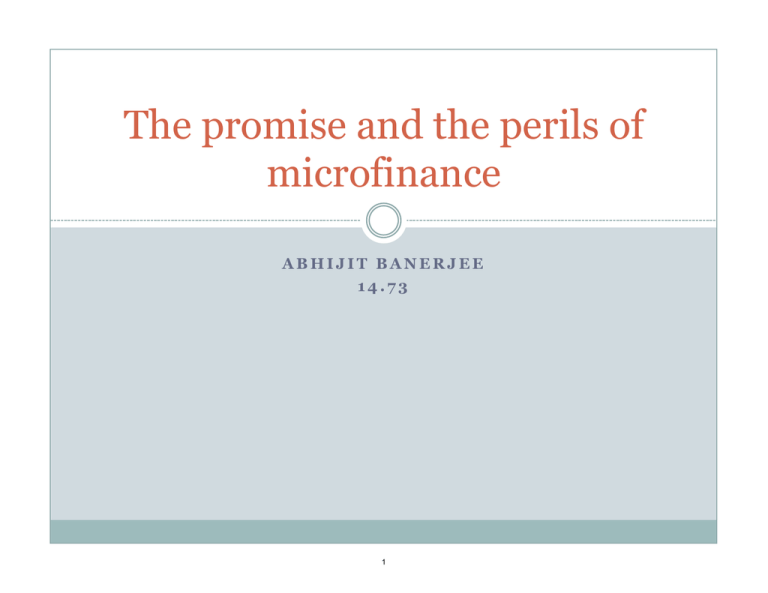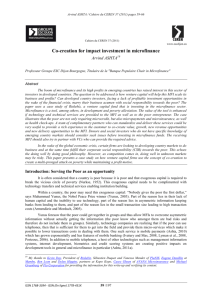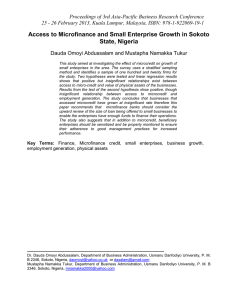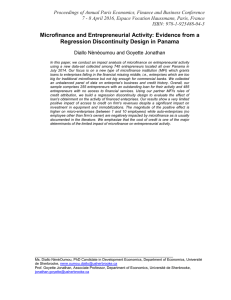The promise and the perils of microfinance 1 4 . 7 3
advertisement

The promise and the perils of microfinance ABHIJIT BANERJEE 14.73 1 The case for microfinance What are the elements of the case beig built up in the microfinance movie? That the poor have poor access to credit That they are reliable borrowers That group lending may help repayment That microfinance can play an important part in lifting people out of poverty That microfinance increases earnings, mainly through new business creation That the increased earning, especially of women, leads to greater investment in human capital That there is no conflict between the commercialization of microcredit and its social role. 2 Questions � We have some understanding of why credit access is bad � How is that consistent with the poor being reliable borrowers? � What role can grouplending play? 3 Questions � Does microcredit have to lift out of poverty to be useful? � Can microcredit help people even if they don’t set up businesses? � How would they repay their loan if they don’t invest? 4 Questions � Why does the gender of the business owner matter? � What could be a source of conflict between the social role of microcredit and its commercial side? 5 How should we interpret the evidence provided in the film? What is the nature of the evidence? ? ? What is problematic about it? ? ? Why do we need an RCT? What else could we do? What are potential problems with it? 6 Spandana’s Program Traditional microcredit program Group liability Weekly or monthly repayment Starting loan is Rs. 10,000 (~$250) Interest rate changed over the period but was around 12% per year (nondeclining balance; ~24% APR) A few individual-liability loans were also given Spandana was already a large MFI in South India Not previously operating in Hyderabad. Agreed to randomly phase in operations in Hyderabad. 7 Endline sample 104 slums: 52 treatment, 52 control ~7,200 households total Households with the following characteristics were surveyed (more likely to become microfinance clients): At least one woman aged 18-55 Household has lived in the slum at least 3 years Not rated as someone Spandana wouldn’t lend to Measures impact for households with these characteristics results for other types of households could be different 9 Households at baseline Family of 5 Monthly expenditure of ~Rs 5,000 (~$125) 98% of 7-11 year olds, 84% of 12-15 year olds in school Borrowing (from friends, moneylenders, etc.) is common (69% of households); average interest rate 3.85% per month Almost no MFI borrowing. 10 Entrepreneurship at baseline 31% of the households run at least one small business (vs. OECD average of 12%) Of these, 9% of households run more than one business But these businesses had few… Specialized skills (mostly general stores, tailors, fruit/vegetable vendors) Employees: Only 10% have any employees; none has more than 3 Assets 20% use no productive assets whatsoever. Scale of businesses: Sales: Rs 13,000 (~$325) per month Profits: Rs 3,040 (~$75) per month 11 Why do you want a loan? 13 (Control) households at endline The average household is a family of 6 (4.7 adu) Monthly expenditure of Rs 6,375 (~$160) 96% of the 7-11 year olds, and 85% of the 12-15 year olds in school Borrowing is very common (89% of households) average interest rate ~2% per month 18.7% have an MFI loan 14 What should we expect Assume: fixed cost of starting a business variable cost of running it When credit access increases: Those without an existing business decide Some will start a business (richer, lower opportunity cost, those with better ideas) Starting a business might involve cutting consumption The rest will just finance consumption Existing business owners don’t face a fixed cost: borrow to increase consumption and variable capital Their profits should go up Overall consumption may go up or down 15 2. TAKE UP? 16 Impact on borrowing 8.3 percentage points more MFI borrowers (Spandana or other) in treatment slums 13.3 percentage points more Spandana borrowers Average of Rs. 1,260 of additional MFI borrowing per household in treatment slums (ITT estimate) These relatively low rates of MFI loan take-up are similar to those found in other J-PAL projects. 17 Impact on business New business Revenues Profits 6,000 5% 7.0% 4,000 5.3% 20,000 6,514 10,000 21,610 14,710 2,000 1,704 0% 0 0 ** For those starting a business: 18 Impact on expenditure Durable PCE * PCE 100 1,000 1,457 1,419 500 50 0 116 0 Business durables Temptation goods * * 10 5 138 50 12.1 74.9 5.3 0 0 19 83.9 Child welfare and women “empowerment” Woman's spending decision Kids in school 1.5 75% 1.0 50% 93.0% 93.0% 0.5 25% 1.39 1.42 0.0 0% Health expenditure Child's major illness 20% 100 138 140 50 10% 0 0% 20 24.0% 24.1% Predicting who is a likely entrepreneur Own land in Hyderabad Spouse is literate Number of prime ae women Own land in village Spouse works for wage 0.0% * 2.5% 21 5.0% 7.5% Start a new business ** New business propensity (treat) 14.0% New business propensity (control) 9.2% 9.8% Any old business (treat) Any old business (control) 8.7% No old business (treat) 2.6% 5.3% No old business (control) 0% 5% 22 10% 15% Durable expenditure ** 192 New business propensity (treat) 137 New business propensity (control) ** Any old business (treat) 235 180 Any old business (control) No old business (treat) 80 No old business (control) 116 0 50 23 100 150 200 250 Non durable expenditure New business propensity (treat) 1,329 New business propensity (control) ** 1,587 Any old business (treat) 1,639 1,574 Any old business (control) No old business (treat) 1,517 1,305 No old business (control) 0 500 24 1000 1500 ** Temptation goods New business propensity (treat) 29 ** New business propensity (control) 69 Any old business (treat) 68 82 Any old business (control) ** No old business (treat) 111 85 No old business (control) 0 50 26 100 The recent crisis Last few years have seen massive entry of for- profits into the microfinance sectors IPO of Compartamos (interest rate 100% or more) yielded huge valuation Inspired by this SKS, India’s largest microfinance had an IPO as well (interest rate 24% or less) Again raised lots of money 27 The new usury � Mohd. Yunus criticized this trend: called them the new usurers � Why did they go for an IPO? � Is it reasonable to criticize them for doing so? 28 The crisis The SKS IPO could not have been worse timed. This showed that they were rich and profitable But this was also when a number of debt suicides happened Set off a political process leading to the promulgation of a new law which is close to shutting the sector down. Suddenly everyone is against microcredit: does the evidence warrant that? 29 MIT OpenCourseWare http://ocw.mit.edu 14.73 The Challenge of World Poverty Spring 2011 For information about citing these materials or our Terms of Use, visit: http://ocw.mit.edu/terms.







